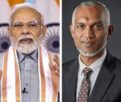Truth of Life- Reality of Death: by Prof Surender Bhatnagar

The earthly existence is relative and we are all evolved and accustomed to live in relations and limitations. But the soul by nature seeks freedom. This is the dilemma of our existence -the split of mind and spirit. The two make an eternal conflict. The day mind makes identity with the reality, it becomes whole and the conflict resolves in full freedom. The reality is thus the other side of relativity.
On the secrets like life and death, Holy Qur’an (S3.179) says, that the mortals will never be disclosed the secrets of unseen and that these will be revealed to the Apostles, exclusively. Nor will He disclose to you the secrets of unseen. But He chooses of His Apostles (for the purpose.)……
What is beyond death, no mortal would ever know and even after the death, it will remain a secret. For the death is the end of existence. Since, as all knowledge is cumulative impressions and even if the soul remains, it does not have any seat for the memory. Then, does it mean that man is eternally condemned for the cage of life and death? Does it mean that in the mortal existence there is no hope for the freedom?
Immortality is not alien to life. The bacteria are immortals. ‘They only grow and reproduce unless they die for want of food, or killed’, John Postgate says in his book “The outer reaches of life”.
But more important than immortality is the knowledge of death and life, while one is living. So the Rishis of past explored the channel of spirit. Not mind, but the spirit, which takes over, as the mind gets silent for all the six states of inner existence. That is the end of ego-ergonomics.
Manonahsh, says Meher Baba, is the final and the real death. It is not the death of body alone, but of the mind as well. When the mind stops working, all imagination stops and with it creation.
Scientists call it the crossing the barrier of thermodynamics. For the mystics it is the opening of the seventh seal – Nirvikalpa samadhi as Vedanta calls. Sufis describe it as Fana fila; Buddhists call it the Nirvana; In Tantra it is called breaking of the Rudra granthi. Those who achieve this state are the perfect ones.
It is all play of mind. Out of that nothing, mind came, from the mind came energy. Energy holds this every thing. Out of mind came this matter. Matter means this everything.
Say Meherbaba ‘Thus everything is linked to everything else. It is all a name game in changing time and space universe”. We must die to self in order to live in God. Thus death is life, according to him.
The story of Nachiketa in Kathopanishada (3000 B.C.) is illustrative. He asked his father, Vajashravas to teach him about death. Since no one knew the story on earth, Vajashravas sends him to the mansion of the Lord of Death. The Lord told him to ask three boons, as a reward of his sacrifice and penance. Accordingly Nachiketa asked three boons.
The first boon. When Nachiketa returns from the state of dead, his father should recognize, believe and accept him with happiness and without remorse. This ensured the return of Nachiketa to the human existence once again. Which the lord of death accepted; saying it will be as you desire.
The second boon was the knowledge and nature of the Agni –the Pranavidhya, i.e. crossing the thermodynamic barrier.
The third boon Nachiketa sought was the secret of death. When he asked this boon, the Lord of Death, King Yama put him to a test and tempted him with many allurements, but Nachiketa remained unfazed, saying ‘the satiation of some wants will give rise to many others and there is no end to this multiplication of wants’. Impressed, the Lord gave him the secret of death and birth. This knowledge is a part of Brahmavidhya -the subject matter of Upanishads.
The death is an illusion of senses; mind is timeless and the soul survives towards an ongoing journey of enlightenment, Deepak Chopra points out in his book “Life after death”. It is the essence of Vedanta. One dies only after enlightenment, which is possible in the human existence alone. Immortality was sought after by the gods, but they too come back to human birth, in order to get the enlightenment. The physical death of the body is not the real death. The real death comes only through awakening of self.
The real death is dying for the world and living for the God, says Meherbaba. The heaven is not outside. God’s abode is not in high heavens, it is within us, Jesus Christ told his followers.
We all die once and born once. In between there are so many births and deaths of little spiritual significance. The significant death is one, when one dies for God, as he achieves enlightenment – the act of the elimination of ego, symbolized by the cutting of one’s head in the sacrifice, which is only performed by the grace of a Sadguru or perfect master – like Shiva did to Ganesha, as explained by Meher Baba (in Bhau Kalchuri’s The Nothing And Everything). The message of the story of Lord Ganesha, who was made to die as man (The son Maya) and was made to rise again as God (son of God) is the same message heard in the resurrection of Jesus Christ, of Phoenix and also that of Osiris.
The Old Testament tells us of a God’s covenant with David “that He will never lack a man to sit upon his thrown”. It means that there will always be a man occupying the throne on earth. They are the Apostles, Perfect Masters and Avatars of the time – who have returned from the throne of God to the mortal existence, to serve humanity- what Meher Baba calls as the “Mastery in servitude”.
Such perfect masters will always be on the earth.
—Syndicate Features
-
Book Shelf
-
 Book Review
DESTINY OF A DYSFUNCTIONAL NUCLEAR STATE
Book Review
DESTINY OF A DYSFUNCTIONAL NUCLEAR STATE
- Book ReviewChina FO Presser Where is the fountainhead of jihad?
- Book ReviewNews Pak Syndrome bedevils Indo-Bangla ties
- Book Review Understanding Vedic Equality….: Book Review
- Book Review Buddhism Made Easy: Book Review
- Book ReviewNews Elegant Summary Of Krishnamurti’s teachings
- Book Review Review: Perspectives: The Timeless Way of Wisdom
- Book ReviewNews Rituals too a world of Rhythm
- Book Review Marx After Marxism
- Book Review John Updike’s Terrorist – a review
-
-
Recent Top Post
-
 NewsTop Story
What Would “Total Victory” Mean in Gaza?
NewsTop Story
What Would “Total Victory” Mean in Gaza?
-
 CommentariesTop Story
The Occupation of Territory in War
CommentariesTop Story
The Occupation of Territory in War
-
 CommentariesTop Story
Pakistan: Infighting in ruling elite intensifies following shock election result
CommentariesTop Story
Pakistan: Infighting in ruling elite intensifies following shock election result
-
 CommentariesTop Story
Proforma Polls in Pakistan Today
CommentariesTop Story
Proforma Polls in Pakistan Today
-
 CommentariesTop Story
Global South Dithering Away from BRI
CommentariesTop Story
Global South Dithering Away from BRI
-
 News
Meherabad beckons….
News
Meherabad beckons….
-
 CommentariesTop Story
Hong Kong court liquidates failed Chinese property giant
CommentariesTop Story
Hong Kong court liquidates failed Chinese property giant
-
 CommentariesTop Story
China’s stock market fall sounds alarm bells
CommentariesTop Story
China’s stock market fall sounds alarm bells
-
 Commentaries
Middle East: Opportunity for the US
Commentaries
Middle East: Opportunity for the US
-
 Commentaries
India – Maldives Relations Nosedive
Commentaries
India – Maldives Relations Nosedive
-
AdSense code




















